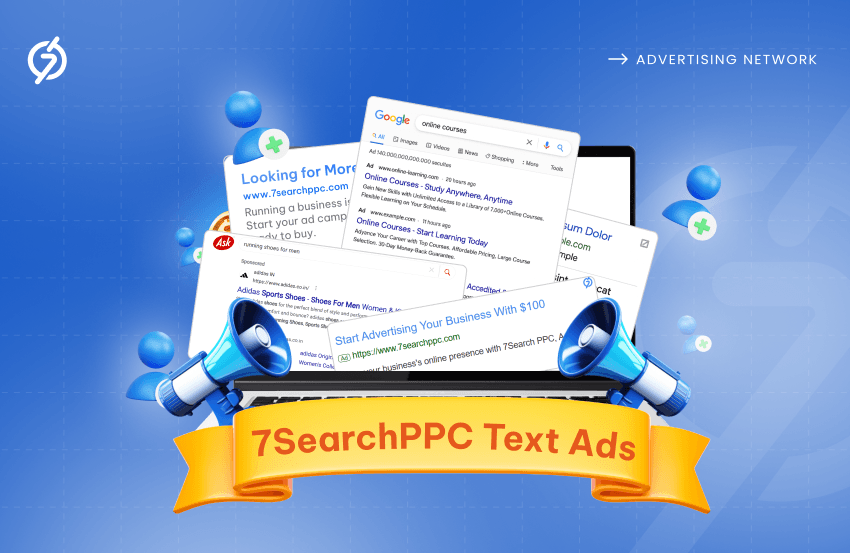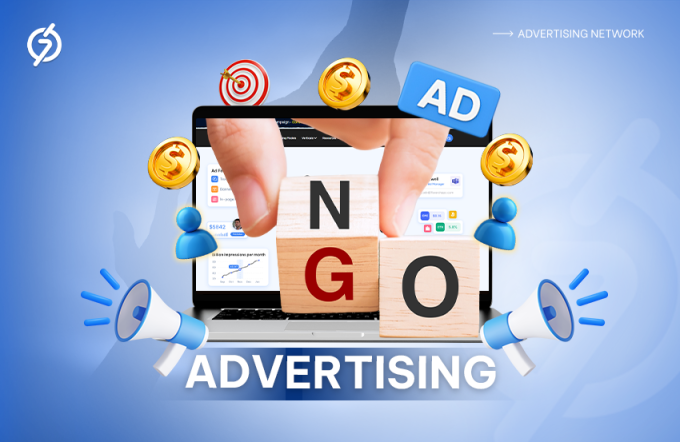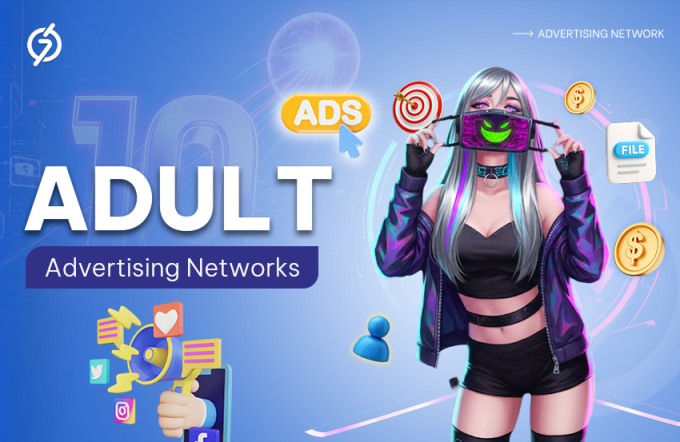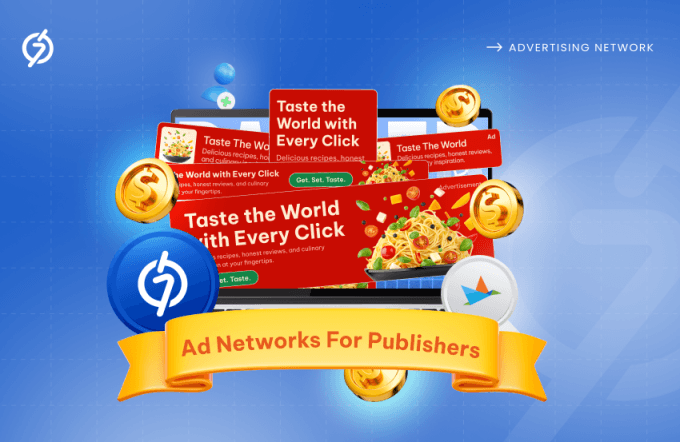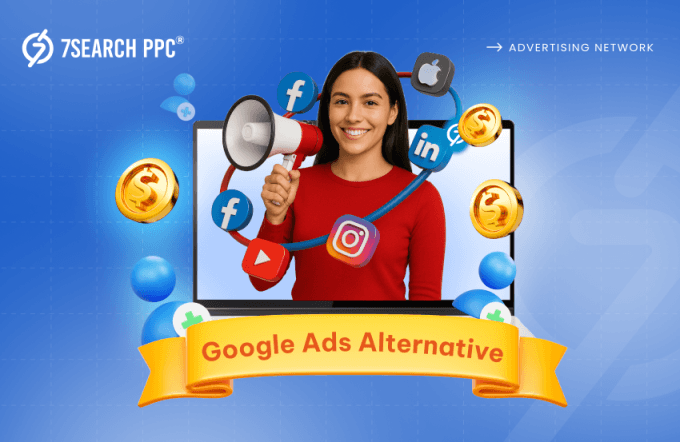Big names don’t always mean better results, especially in digital advertising. While Google Search Ads dominate the market, not every advertiser or publisher finds success there. High competition, expensive keywords, and strict approval policies can make it tough for smaller players to shine. That’s where 7SearchPPC text ads step in with a refreshing approach.
We are an ad network that offers more flexibility, affordability, and opportunity for real growth. Our text ads are a solution that is quietly making a difference.
If you’ve been struggling with Google’s complexity or just want more control over your ad placements, it’s time to explore why 7SearchPPC text ads could be the smarter route for you.
Launch Your First Text Ad Today – It’s Fast, Easy & Affordable!
What are Text Ads?
These ads are different from other online ads. Typically, online ads feature an image or video, a strong message, eye-catching colors, and a clear CTA. However, text ads often consist of just a phrase or line with a CTA, without any visuals.
Here is what text ads mean:
Text ads are short written advertisements designed to promote products, services, or ideas. They appear on websites, search engines, or apps. These ads provide a brief message to attract attention and encourage people to take action.
Key Elements of Text Ads
Key elements of text advertisements include the headline, display URL, and description. Here is a breakdown of each element.
1) Headline
The headline is the first thing people see in a text ad. It grabs attention and tells the viewer what the ad is about. This element is very important from an advertiser’s perspective, as it is one of the deciding factors for customers—whether to click on it or skip it.
Here is how the “Headline” element looks.

2) Display URL
The display URL shows the website address people will visit if they click your text ad.
Here is how the “Display URL” element looks.

3) Description
The description gives more details about what you’re offering. It explains the benefits, features, or a special offer to encourage people to click. This part should be clear, persuasive, and focused on how your product or service helps the customer.
Here is how the “Description” element looks.

When you combine all the elements, this is what a final text ad looks like.

What are Google Search Ads?
Google Search Ads are paid text ads that show up at the top or bottom of Google search results. When you search for something using keywords exactly matching or similar to a product or service in the search box, an ad shows up like this:
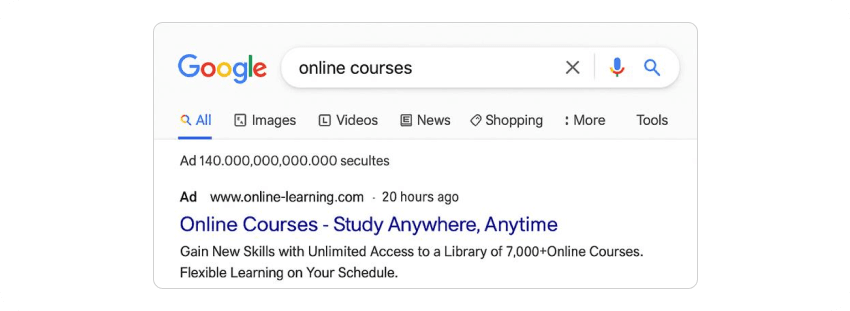
(An example of what a search ad looks like on the Google search engine.)
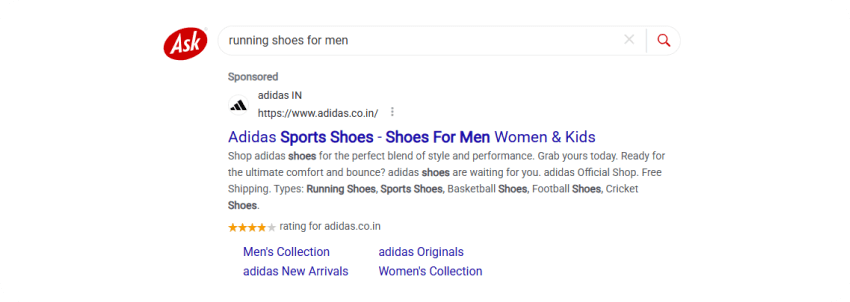
(An example of how a search ad is displayed on a Google search partner site, like Ask.com.)
These ads help connect companies with people who are already looking for what they offer. Google search ads make it easier to attract potential customers quickly and directly.
In 2000, Google AdWords (now called Google Ads) introduced standard text ads. However, in 2022, the platform transitioned to “responsive search ads” as the default format. As of 2025, this remains the primary option for Google text ads.
Drawbacks of Using Google Search Ads for Advertisers and Publishers
Google is the most popular ad platform, but it has created challenges for advertisers and publishers that make it difficult for them to fully achieve its benefits. Here are some drawbacks of using Google Search Ads:
Challenges for Advertisers Using Google Search Ads
Advertisers using Google Search Ads face several key challenges:
1) Strict Google Ad Policies
The first and biggest headache for many advertisers is bypassing Google’s ad policies. Google has strict rules about what advertisers can and can’t show in their search ads. These policies aim to protect users but can make it hard for advertisers to promote certain products or services, like healthcare, financial items, or adult content.
If an ad violates any rule, Google might reject it or even suspend the account.
2) High Cost Per Click (CPC)
Each industry has its own set of keywords that users enter into the search box to find relevant information or products. However, these keywords are not free for advertisers. To display their text ads on intent-based searches, advertisers must bid on high-volume or popular keywords.
But visibility alone isn’t everything. If your text ad gets clicked but doesn’t convert into a sale, you lose money — and that’s the challenge advertisers are facing.
3) Heavy Dependence on Google Search Engine and Partners
Advertisers using Google Search Ads rely heavily on Google’s search engine and its search partner sites to reach their audience. This dependence can be risky because if Google changes its rules, algorithms, or ad placement systems, advertisers might suddenly see drops in performance.
Also, advertisers have no control over where their search ads appear within partner sites, which may affect the ad’s relevance or visibility.
4) Need for Advanced Expertise
Running search ad campaigns on Google Ads is not easy for everyone. It requires deep knowledge of keywords, bidding strategies, landing page quality, and more. Without proper skills or experience, advertisers may waste money on ineffective text-based ad campaigns.
If you are new to Google Ads, you may have to invest more time and money learning about it, which can hinder your growth and give your competitors an upper hand.
5) Restrictive Character Limit
If you’ve used Google Ads for search ads, you may know that there is a character limit for headlines and descriptions. If not, no problem —here are the current limits:
- Headline: 30 characters (max.)
- Description: 90 characters (max.)
This makes it difficult for advertisers to clearly explain their offer or include all the key benefits of their product or service. Writing effective ad copy in a few characters can be difficult, especially when trying to stand out among many other search ads.
6) Impact of Google’s Quality Score
Google gives all text-only ads a ‘Quality Score based on the following parameters:
- How relevant the ad is to users.
- How good is the landing page?
- How often do people click on it?
A low score can raise the cost per click and lower the ad’s visibility. So, even if an advertiser is willing to pay more, their ad could be outranked by competitors with higher quality scores.
Challenges for Publishers Using Google Search Ads
Here are some common challenges publishers face when using Google Search Ads:
1) Low Approval Rates
Getting approved for Google AdSense for Search feels like trying to climb a thousand stairs on one leg — challenging and slow.
Google has strict rules about who can join as a search partner to monetize with search ads. The reality is that many sites don’t meet their quality standards. This means lots of publishers apply but get rejected. It can be frustrating because even if your site is good, Google may still turn you down.
So, the low acceptance rate limits the number of publishers who can benefit from this monetization method.
2) Lack of Control Over Ad Placement
When you use AdSense for Search, you don’t get to decide exactly where the search ads appear on your site. Google automatically places the ads based on keywords and its ad delivery system, which might not always fit your website’s design or user experience.
Read More: Guide To Buying Ad Space And Successful Ad Placement
3) Complexity in Custom Search Bar Implementation
To use AdSense for Search, publishers need to add a special custom search bar on their site that displays Google search ads alongside the results. While this can be a valuable feature for websites that already have an inbuilt search engine—such as large content hubs or directories—it may not be as viable for smaller blogs or content-focused sites where a search bar isn’t typically part of the user experience.
Additionally, the integration process can be technically complex, and many publishers struggle to implement it smoothly, which can lead to errors or a poor user experience.
4) Earnings Based Only on Clicks
With AdSense for Search, you only earn money when visitors actually click on the ads. If people just see the ads but don’t click, you don’t make any money. This means your income depends heavily on how interested your visitors are in the search ads and whether they’re motivated enough to click.
This revenue model will result in very low earnings because Google does not pay anything for impressions.
5) Unfavorable Performance Criteria for Publishers
Google expects publishers to maintain a certain level of performance to keep using AdSense for Search. According to our research, Google will require publishers to meet specific performance benchmarks to keep using AdSense for Search.
To qualify, accounts must have exceeded 20 Search ad impressions in at least two of the six months prior to August 20, 2025. If this threshold isn’t met, publishers will be denied access to the AdSense for Search. This pressure can be tough, especially for smaller or newer websites looking to monetize with search ads.
How 7SearchPPC Text Ads Gain the Upper Hand Over Google Search Ads

(An example of 7SearchPPC text ads)
We know the value of the time and effort that you put into advertising your products and services, or monetizing your website or blog. We also understand that when these efforts don’t lead to success, it can be discouraging.
While Google Search Ads have been there for years, many advertisers and publishers are seeking more advanced and target-based ad formats that drive real results.
That’s where 7SearchPPC comes in. Our text ad format is different from Google search ads. You’ve probably seen text-based ads on search engine results pages or on Google search partner sites like Ask.com or Lycos.com. However, there won’t be many instances where you have seen those types of ads on regular websites or blogs.
7SearchPPC overcomes this limitation by letting you show text ads across relevant websites and blogs. This means advertisers looking to promote their products or services through text ads can easily reach targeted audiences on content-rich sites. Likewise, publishers who want to earn revenue by displaying text ads on their websites or blogs can do so effortlessly with 7SearchPPC.
Thus, our text ads are helping to fill the gap left by Google Search Ads. We proudly claim to be the only advertising network that offers text ads to both advertisers and publishers.
This is just one part of the bigger picture. Our text ads offer unmatched benefits to advertisers and publishers that they need to taste success.
Read More: The Best Text Ad Networks For Advertisers In 2025
Benefits of Using 7SearchPPC Text Ads for Advertisers
We offer a series of benefits for advertisers using 7SearchPPC text ads. Check them out.
1) No Need to Bid on Keywords
When using Google Search ads, you may need to bid high on popular keywords. However, with 7SearchPPC text ads, you don’t have to stress over bidding wars. There is no need to spend your time and budget battling for expensive keywords.
Instead, we offer advertisers the opportunity to bid for getting quality traffic and clicks directly from relevant websites and blogs. This makes the whole process much simpler and helps keep costs predictable.
2) Quality Score Not Required
Unlike Google Ads, 7SearchPPC does not make you deal with the dreaded Quality Score. You don’t need to worry about constantly optimizing your text ads to get a good score. We only check the quality of your text ad. If all things go well, your ad gets approved and goes live — simple as that.
3) Highly Relevant Ad Placement on Niche-Based Websites
One of the cool things about 7SearchPPC is that your text ads are shown on websites or blogs that are closely relevant to what you’re offering. Instead of blasting your text advertisements everywhere, you can show them on niche sites or blogs that cater to the audience you’re actually trying to reach.
This means your contextual text ads get in front of people who are genuinely interested in your product or service. As a result, you have a better shot at conversions without wasting your budget on irrelevant traffic.
Read More: Boosting Your Ads With Contextual Targeting: A Quick Guide
4) Quick Ad Approval
No more waiting around for days to get your text ad campaign approved. With 7SearchPPC, your ads get reviewed and approved in no time. It’s a smooth and quick process, so you can start seeing results much faster.
Whether you’re running a limited-time offer or just want to get your campaign live as soon as possible, the speed at which your text ads go live is definitely a big advantage for you.
5) Simple Text Ad Campaign Setup
Setting up a text ad campaign on 7SearchPPC is super easy. There is no need to be an expert to get started. Our advertiser dashboard is designed to be simple and straightforward, so you can create your text ad campaigns quickly, without facing any issues.
6) Affordable for Small to Mid-Sized Advertisers
If you have a small budget but still want to promote your offerings with text ads, 7SearchPPC is the right destination for you. We offer affordable CPC and CPM pricing models, allowing you to choose the best option for your text ad campaign. And yes, there are no hidden fees.
Read More: CPC vs CPM: Choosing the Best Ad Model for Your Campaign
7) Larger Character Limit Than Google Search Ads
7SearchPPC gives you more room to work with in your text ads, which is a big advantage. Compared to Google Search Ads, where you are restricted to shorter text, our ad network lets you include more details in your text ad.
We allow:
- Headline: up to 60 characters
- Description: up to 150 characters
This means you can say more about what makes your product or service special, explain your offer, and give a stronger call to action – all of which can help drive better results.
8) Complete Flexibility and Control
We offer advertisers complete flexibility and control over their text ad campaigns. It means you can easily change your bids, adjust your targeting options, update your daily or total budget, or even pause and resume your ad campaign anytime. This type of complete control makes you more confident in achieving your text advertising goals effectively.
Benefits of Using 7SearchPPC Text Ads for Publishers
7SearchPPC offers several reasons to smile for publishers looking to monetize their websites or blogs through text ads. What are those reasons? Find them below.
1) Quick Website Approval and Onboarding
Unlike AdSense, we don’t make publishers wait for days to get approved. Once you sign up and add your website to monetize with text ads on 7SearchPPC, we approve it in under 24 hours. There is no long wait, and you won’t have to worry about complex steps
2) Easy Text Ad Code Implementation
One of the hardest parts many publishers face is ad code implementation on their website or blog. But with 7SearchPPC, this is not an issue. We provide the ad code once your website is approved. You just copy and paste the provided code into your website or blog, and the text ads will start showing up.
No need for specialized technical skills or complicated setups. It’s designed to be beginner-friendly, so you can start earning with text ads with minimal effort.
3) Full Control Over Ad Placement
You have complete flexibility when it comes to where you want the text ads to appear on your site or blog. Whether it’s in the header, sidebar, or footer, we offer you full control over ad placement.
4) Earnings Based on Impressions and Clicks
We know the hard work that goes into running a website or blog successfully, so you deserve fair value for it. When you monetize your website or blog with text ads on 7SearchPPC, you make money for every click and impression.
This means that when you display text ads on your website or blog, you earn money each time the ad is shown (impression), and even more when someone clicks on it. You don’t need only clicks to start earning—you can make money from every impression, too.
Read more: 5 Ways To Monetize Your Website: The Ultimate Guide For Beginners
5) Safe Website, and Blog-Friendly Text Ads
We provide text ads that are safe for all types of websites and blogs. Our team reviews each advertiser when they onboard or create a text ad campaign. This ensures that our publishers receive only safe ads, so their reputation and user experience are not harmed. Additionally, our text ads will not slow down your website’s speed.
6) No Strict Performance Criteria
With 7SearchPPC, publishers don’t need to meet strict performance targets to start earning. This means even small or mid-sized websites can easily use text ads to make money with us.
You don’t have to worry about high traffic or big performance goals. If your site gets some visitors, you can still monetize it. We offer a headache-free way to earn, with no pressure to meet tough benchmarks.
Read: Top 16 Google AdSense Alternatives to Monetize in 2025
Google Search Ads vs. 7SearchPPC Text Ads: Key Differences
Now that you understand how our ad network fills the gap while operating similarly to the Google pay-per-click advertising model.
The time has come to compare Google Search Ads and 7SearchPPC text ads one-on-one. This comparison will help you choose the platform that stands out in every aspect.
| Feature | Google Search Ads | 7SearchPPC Text Ads |
|---|---|---|
| Ad Placement | Search engine results (Google only) and Google Search Partner sites | Niche-based websites and blogs |
| Publisher Participation | Not allowed | Fully allowed |
| Cost Per Click (CPC) | Higher due to keyword bidding wars | Lower and more affordable |
| Ad Approval Time | Strict and time-consuming | Quick Approval |
| Targeting | Search intent-based, keyword-targeting | Contextual and category-based |
| Audience Reach | People actively searching on Google and its partner sites | Passive visitors browsing related content |
| Character Limit | Headline: 30 characters Description: 90 characters |
Headline: 60 characters Description: 150 characters |
| Best For | Larger businesses with bigger budgets | Small to medium advertisers, bloggers, and niche publishers |
Conclusion
If Google Search Ads haven’t worked out for you, it might be time to try something better suited to your needs. 7SearchPPC text ads offer a simpler, more affordable, and flexible way to advertise or monetize. Whether you’re an advertiser looking for real results or a publisher wanting easy income, our platform makes it possible without all the extra stress. Give it a try—you might just find the smarter option you’ve been looking for.
Frequently Asked Questions (FAQs)
What are 7SearchPPC text ads?
Ans. 7SearchPPC text ads are short written ads that show up on blogs and websites. These ads include a title, description, and link.
How are 7SearchPPC text ads different from Google Search Ads?
Ans. Google Search Ads show up on Google’s search results. 7SearchPPC text ads appear on regular websites and blogs. This gives advertisers and publishers more flexibility and control.
Do I need to bid on keywords with 7SearchPPC?
Ans. With 7SearchPPC, you don’t have to compete for costly keywords. Instead, you place bids to get quality traffic and clicks directly from relevant websites and blogs.
Is it possible to select specific placements for my ads on Google Search Partner sites?
Ans. No, it’s not possible to create campaigns that exclusively target search partner websites.
How can publishers earn with 7SearchPPC text ads?
Ans. Publishers earn money when people view or click on the text ads shown on their websites. You get paid for both impressions and clicks.
Is there a character limit for text ads on 7SearchPPC?
Ans. Yes, but it’s more flexible than Google. You get up to 60 characters for headlines and 150 for descriptions, so you can say more in your ads.

